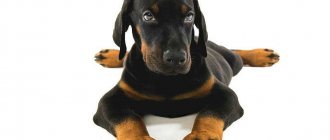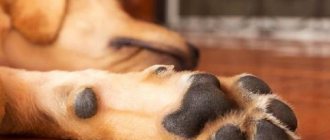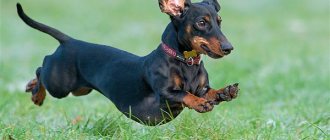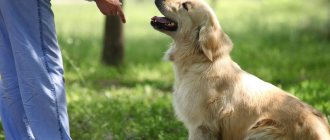Why are dogs given bones to chew on, whether they are healthy or not?
As a food product, they are ineffective for dogs. They are low in calories, are absorbed by the body very poorly, and domestic dogs are simply unable to digest most of them. Even well-cooked bones are dangerous for the animal. When eaten, they are crushed by the teeth; a large number of them can cause intestinal blockage. It’s good if you get by with treatment - laxatives, enemas, etc. If the course is unfavorable, this is surgery. But when purchasing a puppy, many owners immediately have a picture in their head of a dog chewing on a bone. So can dogs be given bones?
It is worth noting that they are suitable for making broth, especially large beef moles. An excellent porridge is then prepared using the broth. These bones contain a lot of cartilage tissue, collagen fibers, and meat remains. This is why dogs love to chew bones - because of their usefulness - collagen and cartilage. Usually these products rarely come to them in their pure form and instincts are triggered. Dogs readily gnaw them. The bone itself remains almost intact. This eliminates known risks.
Gelatinous
Among the variety of artificial food products for animals, gelatin treats occupy a significant place. Made from a natural product, such bones have a number of positive properties. First of all, they perfectly remove food debris from the interdental space, preventing the formation of plaque. In addition, gelatin treats allow the pet to be distracted for a long time while the owner is away. The product is an additional source of collagen for dogs.
Many manufacturers add a variety of useful additives to the product, for example, vitamins and medicinal plant extracts. In a specialized store, the owner will choose a gelatin treat for even the most spoiled pet. Most often, dogs prefer bones that taste like cheese, meat, or cottage cheese. These treats are perfect for rewarding your dog during training.
[custom_ads_shortcode3]
At what age can a puppy eat a bone?
Can I give my puppy bones? Only veal ones, namely the shoulder blade with cartilage, the breast bone and pseudoribs. They contain a lot of chondrin and collagen.
It is recommended to introduce it into the diet from 3 months. After the start of the process of changing teeth. They are not suitable as main food. Can be used as a toy with a pleasant taste from 2 months. It is important to ensure that there are no chips on the bone that could injure your pet. The edges should be round and not damaged. Problems can arise if the animal eats a small bone. A whole, rounded bone with remnants of cartilage and ligaments will benefit the puppy. Especially when his teeth change, he will chew on it, not the furniture.
Older individuals can be given milk from 1-2 year old bulls or calves.
How to give?
If the owner decides to ignore the rules and give his pet a pork bone, he must follow the basic rules that will reduce the likelihood of problems:
- They should be given only after the main feeding. If your dog is hungry, he may rush into the treat too much and choke or chew poorly, resulting in too large pieces going down his throat.
- Make sure that the pork bone does not have sharp edges or cuts. It would be better if it ends with cartilage on both sides.
- The smaller the dog breed, the smaller the treat should be.
- The bone must be fresh and uncooked. You should not give your pet a product of questionable freshness.
Which animal bones can be given and which ones cannot?
Let's find out what bones can be given to dogs, and why?
Beef
The bones of old cows are yellowish and have a lot of beef fat on them. The bones of young individuals are white and practically free of fat. Here's what to remember when going to the market. Pseudo-ribs, sternum, and shoulder blade are excellent. Medium and large breeds love the ridge. Bones also include calf heads. When boiled, this is an excellent dish for a dog. There is meat from the chewing muscles (cheeks), facial muscles, lips, nostrils, nasal septum (cartilage), and brain. It is important to pick off the wool after cooking. It comes off easily. Don't pluck, but kind of roll it up. Before cooking, cut the head in half along the axis of the skull. Tarring is not recommended - the burning smell will remain.
Pork
These bones, like the pork itself, are very fatty. In addition, they are porous, because they slaughter mainly young individuals. Dogs eat such bones almost completely. Is it possible to give a dog pork bones with these characteristics? No. It is worth noting that the pork snout consists of cartilage, muscle and skin. You can give it raw 1-2 times a week. Freeze before feeding!
Chicken
Bird bones should not be given to dogs at all. And here's why dogs shouldn't be given chicken bones. They are thin, soft, have a lot of meat and cartilage left on them, and dogs willingly eat them. If they simply gnaw off large beef bones and leave the bones themselves, then birds can eat large quantities (necks, wings, skeletons, heads) and completely. This is very harmful and dangerous. The very quality of the bones, like broiler chicken from the factory, is questionable.
Although many people recommend chicken necks even abroad (BARF) without fear of anything, not even allergies.
Turkey
Turkey bones differ from chicken bones only in size. All recommendations will be the same as for chicken bones.
A rabbit
Rabbit bones are very small and have many tubular bones. As a delicacy, the backbone and pelvis can be given to large dogs. Infrequently. The head deserves special attention; most dogs do not eat the teeth and leave them alone.
Lamb
These bones, like veal bones, are very good. But you should take the same precautions as with other bones for your animal. It is not recommended to use them as the basis of your diet.
Elk, roe deer, wild boar
They must be frozen deeply and then be sure to be thoroughly boiled. The threat of trichinosis is much higher. Considering the risks, each owner decides for himself. If you choose them, then follow the same recommendations as described above.
Chewable
In the assortment of the pet store there is always a product for chewing by pets of a wide variety of sizes. Thus, bones for small dogs are small in size. When choosing an artificial substitute, the owner should be guided, first of all, by safety. Manufacturers who produce chewing bones for animals, as a rule, detail in the instructions for dogs what breeds and what weight a particular product is intended for.
To help in choosing a chewing bone for your pet, advice from the seller or consultation with a veterinarian will help. Puppy owners should be aware that most chew bones are not suitable for babies under 4 months of age.
[custom_ads_shortcode2]
Artificial bones for strengthening and cleaning teeth - benefits and harms
Chewable (gelatin)
They are a safe toy. Puppies readily gnaw on it when changing teeth. Manufacturers produce for specific breed groups. But it is not always clear how chewing bones for dogs are produced; here it is also worth choosing a manufacturer, keeping an eye on his reputation. Excessive feeding is fraught with gastrointestinal problems.
Rubber
They are a simple toy for your pet like a ball, rubber pig or chicken. Great for leisure time. When choosing in a store, it is recommended to ask for a certificate of quality and safety of a rubber product. The choice of color and size is yours.
Pressed from veins (tendons)
The most useful type of artificial seed. They are more expensive, but they also provide more benefits. They contain natural chondrin. It is very useful for puppies and adult animals. It is important not to overfeed the animal with this product. Dogs love him very much. This is becoming one of my favorite treats. The veins in them are steamed and crushed before pressing. They are safe, but in large quantities they will become harmful.
Boiled or raw?
Boiled bones, no matter whether they are pork or any other, should not be given to your pet. After consumption, they accumulate in the animal’s digestive tract into a very dense mass and clog the intestines.
This can cause not only constipation, but also complete obstruction.
In severe cases, it will be impossible to solve the problem without surgery. Attention! Particularly dangerous are the bones that remain after preparing jellied meat. They should not be given under any circumstances.
Which dog breeds can be fed bones and which cannot?
It is recommended to give high quality natural bones to medium and large breeds, but only as a treat. You can give them to puppies when they change teeth, as a tasty toy.
Small breeds do not have such physical characteristics and bones are contraindicated for them. Such dogs often have problems with teeth - another reason for the disadvantage of giving a bone. The pet industry produces various artificial options for them. It is very good sometimes to give a pressed look from veins of the appropriate size. Gelatin ones are less nutritious.
Which pets are strictly contraindicated for bones?
Veterinarians do not always approve of the use of cartilage and bones. Bones are prohibited for older individuals, as they can damage already weak teeth. In addition, the solid product causes problems with the functioning of the gastrointestinal tract and leads to chronic constipation
In puppies up to 3 months old, hard parts stop the growth of canines and provoke malocclusion. The same problem may accompany the use of moslov in individuals participating in exhibitions. Using bones as a toy causes abrasion of enamel, breakage of teeth and spoils the appearance of champions.
Possible dangerous consequences
When a dog eats bones, it chews them into small pieces. But it is very difficult for the body to digest them. A semi-digested porous mass accumulates. The consequence is difficulty in excreting feces and the appearance of blood. If the bones continue to be absorbed in the same quantity, the intestines become clogged. If you contact a veterinarian in time, you can get by with a deep enema and a laxative. Then you will need a strict diet.
If the blockage is so large that it cannot be washed out, or there are several foci, there is only one way out - surgery. An ultrasound will show everything. In a critical case, necrosis of the intestinal wall may occur due to circulatory problems. This applies to everyone, even dogs of the largest breeds. If the outcome of the operation is favorable, rehabilitation lasts quite a long time.
It is much more dangerous when a sharp piece of bone pierces the intestines or stomach, and sometimes in several places (the intestines are laid out in loops). The likelihood of peritonitis is very high. Surgery is inevitable. Treatment will include very powerful antibiotics.
Older dogs may have dental problems. Bones carry a high load on them.
A pet can also choke on a piece of bone, but this happens extremely rarely.
What to do if you eat it?
The first thing a dog that has eaten too much pork bones and is experiencing discomfort will do is refuse to eat.
Other symptoms of intestinal damage:
- the animal moves little, avoid taking painful positions;
- when pressing on the abdomen, he experiences pain and whines;
- vomiting occurs;
- in severe cases, the pet cannot get up.
Damage to the inner walls of the digestive tract is indicated by blood in the stool or vomit.
If a dog has voluntarily eaten pork bones, the following will help prevent unwanted problems in the body:
- Diet. The animal should be put on a light diet for the next 3-4 days. Liquid food will help not overload the intestines and create optimal conditions for the release of bones.
- Movement. Active walks will improve gastrointestinal motility.
- Vaseline oil. Give 2-3 ml for a small dog, 10-12 for a medium-sized dog and 20-25 for a large dog every 12 hours. The substance will lubricate the intestinal walls and help push through stagnant food.
Important! Do not try to remove a crushed pork bone from the mouth or induce vomiting in the animal. This can lead to injury to the digestive tract.
If within 3-4 days after the dog ate too many bones, the condition did not worsen, then it was able to digest the food.
However, if the dog has lost appetite and vigor, and has stopped going to the toilet, you should consult a veterinarian. Probably, a plug formed in the intestines from what was eaten.
An enema will help cope with constipation after eating pork bones in a dog. You can perform intestinal lavage with regular tap water at a comfortable temperature (29-31 degrees).
Using a syringe, liquid is injected into the animal's rectum. Water can be replaced with Vaseline oil. For a dog weighing more than 45 kg, you will need 1 glass, for small breeds - 2-3 spoons.
If your pet cannot move independently, you should not force him to stand up or try to carry him in your arms. The animal can only be transported on a stretcher, which you can build yourself from available items.
What bones do dogs like and why?
Sugar brains
These are large, juicy bones of young farm animals. They are white in color, and the bone tissue of the trochanters is relatively soft and well saturated with blood vessels. A lot of bone marrow. They are quite easy to chew. The amount of cartilage tissue is high and it is easily separated from the bone body. The porous structure of skewers is easily digested by large dogs and is not visible in feces. Problems may arise with constant feeding.
Beef ribs with leftover meat
The intercostal muscles are very nutritious and pleasant to the taste. Animals willingly eat the ribs themselves whole (young farm animals). This is especially true for pseudo-edges.
With cartilage
Cartilage tissue carries a large amount of collagen and chondrin to the dog. It is a building material for joints and tendons. It is useful for growing cheeks, for adults to maintain shape, and for elderly people for prevention. They are loved by all categories. Most of the cartilage is on the sternum, pseudoribs (outer ribs not fused to the sternum), and shoulder blades. There is a lot of cartilaginous tissue in veal heads and pig snouts.
Chicken
Chicken bones for dogs, however, like any other animal origin, according to veterinary specialists and experienced dog breeders, should not be given to four-legged pets. This is not the safest option. Natural bones often provoke diarrhea, bleeding, gastritis, and ulcerative lesions of the digestive tract in animals.
In severe cases, bone fragments can lead to intestinal blockage and gastric volvulus. The best option would be to replace a natural product with an artificial analogue. Among the numerous variety of industrial treats, a caring owner can easily find an artificial chicken-flavored treat for a picky pet.
Watch this video about the benefits of rawhide bones for dogs:
[custom_ads_shortcode1]
Useful tips for introducing bones into the diet depending on the breed
Such:
- Puppies should be given bones from the moment their teeth begin to change.
- The bones must be of young farm animals and frozen.
- Chips and sharp edges are not allowed.
- Give bones 2-3 times a week.
- They are not suitable as the basis of a diet.
- The most useful are brisket, pseudoribs, veal heads (boiled).
- Chicken bones are extremely dangerous (necks are an exception).
- Natural bones are not recommended for small breeds.
- Of the artificial ones, the most useful are the pressed veins. Gelatin ones are just a treat. Rubber - a toy.
- The bones must be fresh, from young farm animals, white and free of fat.
Death at the end of a needle and other dangers
The first and most important reason for concern is that the bone formations of a rabbit, turkey, goose, chicken or any other bird easily break under the animal’s teeth and crumble into small plates - thin and sharp, like a needle. Once ingested by a pet, such a treat can seriously injure the mucous membrane and cause perforation of the stomach or intestines. In the latter case, the dog can be saved from death only by a timely operation - resection, which involves removing a significant part of the damaged organ.
photo from website: holidogtimes.com
So bones are no joke, especially tubular ones. Undesirable consequences that are possible after feeding a dog with them include:
- Poisoning of a dog by pathogenic microorganisms and bacteria accumulating in a dubious treat.
- Violation of the integrity of tooth enamel or damage to the oral cavity.
- Digestive problems – indigestion and constipation.
- Profuse vomiting caused by a bone stuck in the stomach.
- Choking due to unchewed plates getting into the throat.
As you can see, there are dangers at every step. Isn’t it easier to completely refuse such a product from your diet and replace it with something absolutely healthy and safe - for example, the same broth that retains all the beneficial nutrients of moss?
However, if skeletal parts of birds are prohibited, why not prefer them to those that support mammalian meat - for example, pork or beef? It turns out that there are some nuances here too.
photo from website: istockphoto.com











